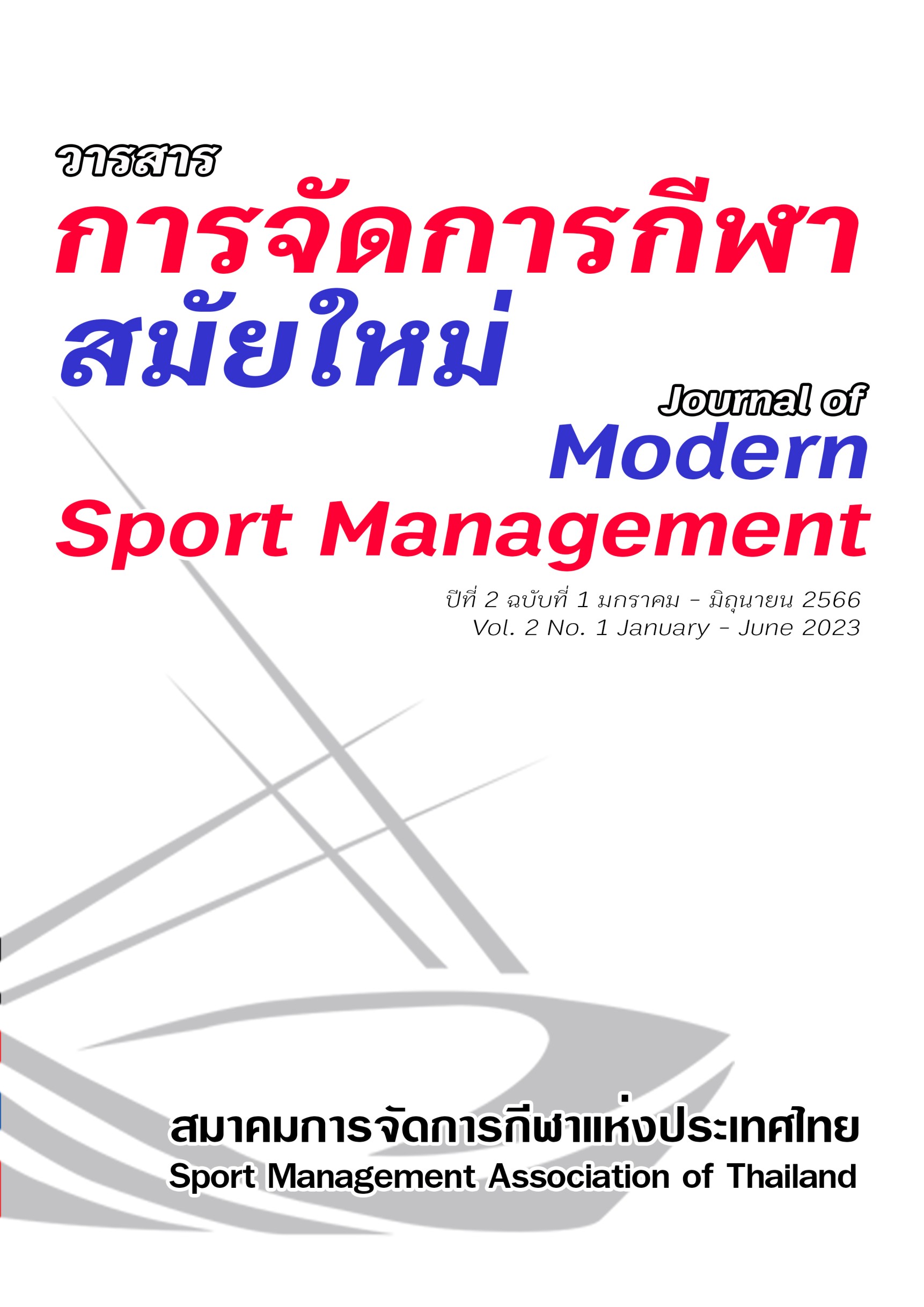ปัจจัยที่ส่งผลต่อการสร้างพันธมิตรสนับสนุนกีฬาอาชีพในประเทศไทย
Main Article Content
บทคัดย่อ
พันธมิตรสนับสนุนกีฬาอาชีพคือความสัมพันธ์ระหว่างองค์กรกีฬาอาชีพ (Sporting Organization) และผู้สนับสนุน (Sponsor) ในปัจจุบันรูปแบบความสัมพันธ์ได้วิวัฒนาการมาสู่ยุคของความร่วมมือในรูปแบบพันธมิตรทางธุรกิจ ความสัมพันธ์นั้นอยู่ในรูปแบบข้อตกลงทางธุรกิจโดยข้อตกลงนั้นต้องสามารถเกิดประโยชน์ในทางธุรกิจทั้งสองฝ่ายในรูปแบบของผลประโยชน์ต่างตอบแทน ซึ่งเป็นความสัมพันธ์ระยะยาวที่มีความซับซ้อนและความสำเร็จจะเกิดขึ้นได้จะต้องมีการพัฒนาความสัมพันธ์เพื่อให้บรรลุเป้าหมายร่วมกัน บทความวิจัยนี้จึงมีวัตถุประสงค์เพื่อศึกษาปัจจัยที่ผู้จัดการองค์กรกีฬาอาชีพ (Sporting Organization) และผู้จัดการองค์การผู้สนับสนุน (Sponsor) ใช้วิเคราะห์คู่ค้าพันธมิตรและส่งผลต่อการตัดสินใจเลือกคู่ค้าพันธมิตรสนับสนุนกีฬาอาชีพในประเทศไทย โดยใช้การวิจัยเชิงทดลองแบบสองกลุ่มวัดหลัง (Posttest-Only Design) แบ่งการทดลองทั้ง 5 ปัจจัยออกเป็น 2 เงื่อนไขในแต่ละปัจจัย ได้แก่ คู่ค้าที่มีระดับปัจจัยสูงและคู่ค้าที่มีระดับปัจจัยต่ำ กลุ่มตัวอย่างที่ใช้ในการวิจัยเป็นผู้จัดการที่มีประสบการณ์โดยตรงจากองค์กรกีฬาอาชีพ (Sporting Organization) จำนวน 200 คนและจากองค์การผู้สนับสนุน (Sponsor) จำนวน 200 คน ทำการเก็บรวบรวมข้อมูลโดยใช้แบบสอบถามที่ผ่านการตรวจสอบจากผู้เชี่ยวชาญ นำผลที่ได้มาวิเคราะห์ค่าทางสถิติโดยหาค่าเฉลี่ย ส่วนเบี่ยงเบนมาตรฐาน การทดสอบค่า ที (t-test)
ผลการวิจัยพบว่าค่าเฉลี่ยของระดับการตัดสินใจเลือกคู่ค้าพันธมิตรของกลุ่มทดลองที่มีเงื่อนไขกำหนดระดับคุณลักษณะของคู่ค้าที่ปัจจัยสูง/ต่ำ มีความแตกต่างกันอย่างมีนัยสำคัญทางสถิติที่ระดับ 0.05 ทั้ง 5 ปัจจัย จึงสรุปได้ว่าผลที่ได้เป็นไปตามสมมติฐานการวิจัย ดังนั้นผู้จัดการองค์กรกีฬาอาชีพ (Sporting Organization) และผู้จัดการองค์การผู้สนับสนุน (Sponsor) วิเคราะห์และตัดสินใจเลือกคู่ค้าเพื่อเข้าสู่การสร้างพันธมิตรสนับสนุนกีฬาอาชีพในประเทศไทย โดยใช้ 5 ปัจจัย ได้แก่ มูลค่าอัตราผลตอบแทน (ROI) สูงสุด ระดับความสัมพันธ์ของเครือข่ายทางธุรกิจ ความเสี่ยงที่เกิดจากภาพลักษณ์ด้านลบ ความสอดคล้องเชื่อมโยงทางกลยุทธ และขั้นตอนกระบวนการอันเป็นอุปสรรค
Article Details

อนุญาตภายใต้เงื่อนไข Creative Commons Attribution-NonCommercial-NoDerivatives 4.0 International License.
เอกสารอ้างอิง
Anderson, E. W., Fornell, C., & Lehmann, D. R. (1994). Customer satisfaction, market share, and profitability: findings from Sweden. Journal of Marketing, 58(3), 53-66
Becker-Olsen, K., & Simmons, C. J. (2002). When do social sponsorships enhance or dilute equity? Fit, message source, and the persistence of effects. Advances in Consumer Research, 29(1), 287-289.
Carrillat, F. A., & d’Astous, A. (2014). Power imbalance issues in athlete sponsorship versus
endorsement in the context of a scandal. European Journal of Marketing, 45(6), 882-909.
Chien, P. M., & Kelly, S. J. (2016). Sport scandal and sponsorship decisions: Team
identification matters. Journal of Sport Management, 30(1), 490-505.
Cobbs, J. B. (2011). The dynamics of relationship marketing in international sponsorship
networks. Journal of Business & Industrial Marketing, 26(8), 590-601.
Cornwell, T. B. (2014). Sponsorship in marketing: effective communication through sports,
arts and events. New York: Routledge.
Cornwell, T. B. (1995). Sponsorship-linked marketing development. Sport marketing Quarterly, 4(4), 13-24.
Crompton, J. L. (2015). Potential negative outcomes from sports sponsorship. International
Journal of Sports Marketing and Sponsorship, 16(3), 20-34.
Douvis, J., Sarli, E., Kriemadis, A., & Vrondou, O. (2015). An Analysis of Sponsorship Deals in
Sport. International Journal of Sport Management, Recreation & Tourism, 17(1), 14-36.
Farrelly, F., Quester, P., & Clulow, V. (2008). Exploring market orientation and satisfaction of partners in sponsorship relationship. Australian Marketing Journal, 16(2), 51-66.
Farrelly, F., & Quester, P. (2005). Investigating large-scale sponsorship relationships as
co-marketing alliances. Business Horizons, 48(1), 55-62.
Fleck, N. D., & Quester, P. (2007). Birds of a feather flock together: Definition, role and measure of congruence: An Application to sponsorship. Psychology & Marketing, 24(11), 975–1000.
Gwinner, K. (1997). A model of image creation and image transfer in event sponsorship. International Marketing Review, 14(3), 145-158.
Hughes, S., & Shank, M. (2005). Defining scandal in sports: Media and corporate sponsor
perspectives. Sport Marketing Quarterly, 14(1), 207-216.
Jensen, J. A., & Cornwell, T. B. (2017). Why do marketing relationships end? Findings from an integrated model of sport sponsorship decision-making. Journal of Sport Management, 31(1), 401-418.
Johnston, M. A. (2015). The sum of all fears: Stakeholder responses to sponsorship alliance
risk. Tourism Management Perspectives, 15(1), 91-104.
Johnston, M. A., & Paulsen, N. (2014). Rules of engagement: A discrete choice analysis of
sponsorship decision making. Journal of Marketing Management, 30(7-8), 634-663.
Kelly, S. J., Ireland, M., Mangan, J., & Williamson, H. (2016). It works two ways: Impacts of sponsorship alliance upon sport and sponsor image. Sport marketing Quarterly, 25(1), 241-259. Kulczycki, W., & Koenigstorfer, J. (2016). Why sponsors should worry about corruption as a mega sport event syndrome. European Sport Management Quarterly, 16(5), 545-574.
McDaniel, S. R. (1999). An investigation of match-up effects in sport sponsorship advertising: The implications of consumer advertising schemas. Psychology & Marketing, 16(2), 163–184.
McDonald, P., & Gandz, J. (1991), Identification of values relevant to business research. Human Resource Management, 30(1), 217-236.
Masterman, G. (2007). Sponsorship For a return on investment. USA: Butterworth-Heinemann.
Mitrega, M., Forkmann, S., Ramos, C., & Henneberg, S. C. (2012). Networking capability in business relationships concept and scale development. Industrial Marketing Management, 41(1), 739–751.
Ouchi, W. G. (1979). A conceptual framework for the design of organizational control Mechanisms Management Science, 25(9), 833-848.
Ryan, A., & Fahy, J. (2012). Evolving priorities in sponsorship: From media management to
network management. Journal of Marketing Management, 28(9-10), 1132-1158.
Shah, R. H., & Swaminathan, V. (2008). Factors influencing partner selection in strategic alliances:
The moderating role of alliance context. Strategic Management Journal, 29(1), 471-494.
Speed, R., & Thompson, P. (2000). Determinants of sports sponsorship response. Journal of the Academy of Marketing Science, 28(2), 226-238.


